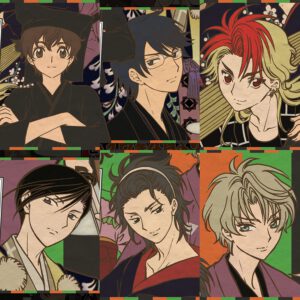
Animes about the arts are a high abundance genre. Having just completed one about rakugo, I was interested in kabuki. I do not know if this is the show to fully explain the art form, but we have a goodly attempt with “Kabukibu!”
Our young tyro, Kurogo Kurusu (top row, left), is a kabuki nut. He adores it to the point where you have to clobber him in the back of the head with a snow shovel to get him to shut up about it. At his high school, he wants to start a kabuki club, where they learn about and even perform this ancient art form. However, getting people to sign up on this is almost a lost cause. You see, kabuki is very ritualized and modern audiences are just not into it. Others entertainment venues are easier to understand and do not demand as much from you.
Kurusu wants to change all of that and begins to assemble his cast-off characters…..I mean, cast of characters (left to right):
Top Row:
Tonbo Murase, a good friend of Kurusu, has a bit of stage fright.
Shin Akutsu, comes from kabuki but wants to be a rock star.
Bottom Row:
Jin Ebihara. He IS a kabuki performer.
Hanamichi Niwa, rather graceful, but prefers martial arts to be more ‘macho’.
Kaoru Asagi, that guy is actually a girl, but she’s so smooth, other girls adore her.
Not pictured is Riri Miwayama, Niwa’s childhood friend and current classmate.
Jin is the key missing component (or perhaps combatant), but he feels he is not up to snuff, compared to his grandfather, a National Living Treasure. Because of this, he feels that Kurusu is a dilettante in these matters and dishes out steaming bowls of hostility towards him and his foolish desire for kabuki.
In fact, Kurusu runs afoul of almost everyone, as they feel it is a waste of time and people don’t understand it, anyway. But he is able to forge together some tight acting bonds to move things forward and achieve his goals. With kabuki, it is an art form I am less familiar with than rakugo, so a lot of the stories do not make immediate sense to me or how they should be presented. In that sense, I am like his target audience who may not have experienced kabuki, but he is trying to help me understand this art form and come to appreciate it.
In that sense, the show succeeds well, as they are able to convey what it is all about. Also, with some daring approaches to the presentation, he shows how to connect with the audience so they understand the point of the tale. This is not a dense show, but it tries to cover a lot of territory in its first season. Yes, yes, yes. Since many of the problems have yet to be resolved, the potentiality of a second season is very strong.
After having seen the rakugo series, I wanted to see how they approached things with this one. It is not as confrontational and wracked with guilt as that series, so things are a bit easier to take in. And I think you should take it in, if just to see how one tries to take something ancient and steeped in traditions and makes it relevant to our modern life and times. And you have to binge this, as the story weaves together much tighter with running through it at a go than a week-to-week approach, as you can get a better feel for the levels of commitment that everyone donates to the project.
On a scale of 1 to 10:
Artwork 7 (A standard approach)
Plot 7 (Seems strained in parts)
Pacing 7 (Moves along consistently)
Effectiveness 8 (Good use of back stories)
Conclusion 7 (It reaches a ‘coupler point’, but hasn’t ended)
Fan Service 0 (A similar show would be “Honey and Clover”)
Bingeability 9 (Helps with the pacing and understanding of things)
Overall 7 (Good approach, but needed a smidge more)
And remember, it’s first run until you’ve seen it. What do you know about kabuki?
Leave a Reply